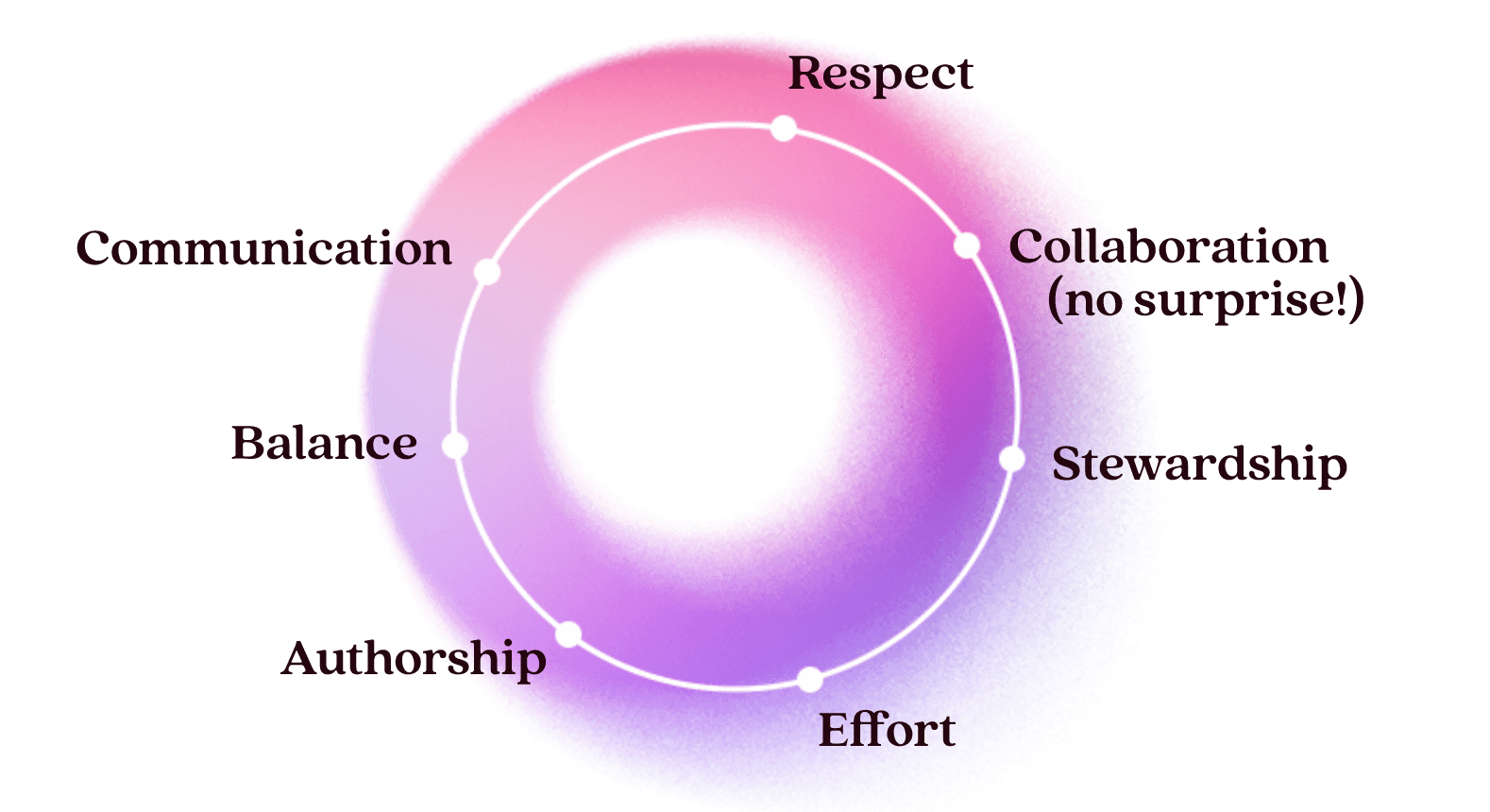
Our earliest memories of collaboration stem back to the dreaded class project. If you’re like us, your teacher “randomly” assigned the groups. If you’re also like us, you were The Person Who Does All The Work in The Group, Including Stitching Everyone’s Lackluster Contributions Together and Fixing Them at the Last Second.
“I can’t wait until I’m grown up and I can just do it all myself,” we’d grumble.
The joke, however, was on us. Life is one big series of collaborations, and the world would be a hot mess without them.
We collaborate by pulling over for emergency vehicles, returning our grocery carts instead of abandoning them in the parking lot and playing in awkward adult kickball leagues. We collaborate with colleagues, friends, family and even total strangers.
Collaboration can be a fulfilling, daunting or haunting experience. In a bit, we’ll talk about how you can avoid crummy collaborations. First, let’s start with an exercise:
What fuels productive, positive collaborations?
Agency-client collaborations aren’t always 50-50 relationships — and that’s OK! Start from a place of honesty and emotional safety to set everyone up for success.
Think about the people you enjoy collaborating with, whether you’re creating a great solution for a client, organizing boxes at an animal shelter or planning a big surprise birthday party together. (Are you smiling? Good. You’re on the right track.)
Next, list the commonalities among these collaborations. Do they make you feel supported or validated? Does everyone bring something unique to the table, and is everyone’s voice heard? Are you accomplishing something important together — and having fun while you’re at it?
And finally, list what’s missing from these collaborations. Bullying, fear and apathy are the first three words that came to mind for us. No one forces their ideas on the group. No one is shamed for a “wrong” solution. No one gives the bare minimum.
So what fuels these productive, positive collaborations? Everyone involved is invested in the outcome, shares a common definition of success and trusts their collaborators.
That can feel like a tall order, especially in agency-client relationships. These collaborations aren’t always 50-50; for example, it’s appropriate for agencies to own the project (that’s why clients pay us). But a successful outcome depends on investment and trust from both parties.
Bigmouth believes productive, positive client collaboration should be the rule, not the exception — one of the many reasons we created a new kind of agency. Here’s how we’re building the relationships to get there.

1. Start by knowing ourselves
Before you can build great client relationships, you need a strong internal foundation built on shared values. What’s more: You need to collaboratively define, document and live those values to keep everyone on the same page.
After many years of conducting brand workshops with our clients, we’ve found a surprising amount of alignment between our personal values and the values of the people and companies we choose to work for.
That’s why the act of defining our values can feel so vulnerable — it’s a deeply personal act on a professional stage. Shared vulnerability also builds trust and brings everyone closer together—so be brave for one another!
At Bigmouth, we walk our clients through a few different values-finding exercises when building their new brand. We’ll share them with you in a future post. While you wait, check out our seven Bigmouth values:

2. Share a common definition of a successful collaboration
Once your team understands your collective values, it’s much easier to define your ideal client collaborators. It’s unlikely you’ll align on every single value, though obvious green lights and red flags tell you whether a client is a “let’s go” or a “heck no.”
At Bigmouth, we rely on the four Fs:

When deciding whether to work with a new client.
The ratio of each is subjective, but a Fit is non-negotiable.
A client’s desire and ability to collaborate are a major green light for us, too. We often take on clients who have never worked with an agency and lack a “creative” vocabulary. These clients are excited about the work ahead and ready to learn on their feet. Their honesty about their skills and shortcomings helps us come to the best solution together.
We define our red flags as individuals and as a group. Before responding to an RFP or chatting with a potential client, our owner, Jonathan Hart, asks for any objections. If even a single team member is uncomfortable, for any reason, it’s a no. Full stop. This “team over everything” policy is just one example of our values in action.
3. Get to the solution — together
Both parties have signed on the dotted line, and you’re off to the rodeo!
Hold on there, cowpoke. As you get in the trenches together — before you start producing work — use your kickoff meeting to collaborate on some important parameters.

Set mutual expectations.
What inputs do you need from one another? How many rounds of revisions will you complete? Do you prefer a more collaborative process (lots of workshops) or individual (evaluate and regroup) process? What pace of work is best for everyone? Revisit the answers to these and other key questions throughout your collaboration.

Understand your values and vulnerabilities.
As we mentioned earlier, this may be the very first time your clients work with a creative agency. Small-business clients in particular often have very personal ties to their brand and company, and bristle at the idea of change. Frame your collaboration as a moment to build on past success and transform it into a greater future.
Also, remember that clients have faced workplace traumas of their own and bring those experiences to your working relationship. Respond with empathy whenever possible; clients are temporary members of your team and deserve a safe space for vulnerability.

Teach clients how to evaluate your work.
Whether clients have worked with an agency in the past or are newbies, they may not be equipped with the skills to give constructive feedback. (And everyone can benefit from a reminder.)
Define “specific” feedback. “Did you like it?” isn’t enough. Include a list of parameters for evaluating work in your presentation decks, as well as a list of questions. Don’t be afraid to ask clients to be constructive and specific in return.
Use delays as an opportunity. It’s easy for agencies to get SUPER frustrated by slow clients. How can they not understand they’re holding us up? It’s been like THREE WEEKS.
Delays are another example of collaborations that stray from the 50/50. It’s easy for agencies to feel like clients aren’t equally invested in the work. That’s because the work doesn’t equally occupy our days. Agencies focus almost entirely on client work; agency work occupies a small part of a client’s day.
Respectfully vent your frustration to your internal team. Then, have a conversation with your clients. Help them understand why delays hinder productivity and create a “moving ahead” plan.


Bigmouth is on a mission to do good — and authentic relationships do good for our agency and our clients. We all carry traumas from bad working relationships (and class projects) with us. By choosing to be vulnerable and trust the potential of positive collaboration, we’re creating a world we want to work in.
We can’t do it all ourselves — join us! Bigmouth turns five in 2023. As part of our celebration, we’re publishing a five-part blog series on leadership in today’s creative world.
Sign up for our newsletter to stay in the loop and become part of our creative community.
In our next post, we’ll explore the “why” and “how” behind leading with vulnerability.